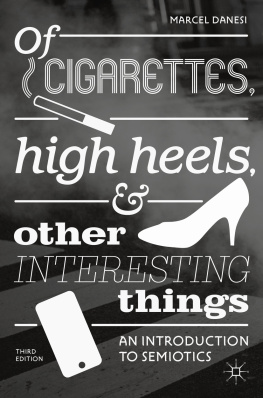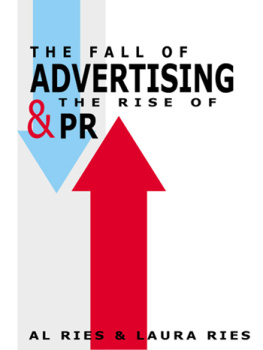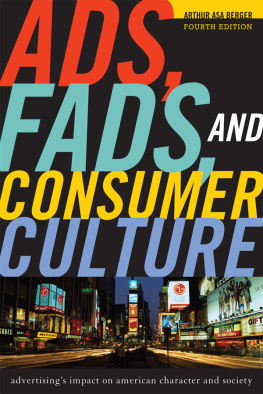Why It Sells
Why It Sells
Decoding the Meanings of
Brand Names, Logos, Ads, and
Other Marketing and
Advertising Ploys
Marcel Danesi

ROWMAN & LITTLEFIELD PUBLISHERS, INC.
Published in the United States of America
by Rowman & Littlefield Publishers, Inc.
A wholly owned subsidiary of The Rowman & Littlefield Publishing Group, Inc.
4501 Forbes Boulevard, Suite 200, Lanham, Maryland 20706
www.rowmanlittlefield.com
Estover Road, Plymouth PL6 7PY, United Kingdom
Copyright 2008 by Rowman & Littlefield Publishers, Inc.
All rights reserved. No part of this publication may be reproduced, stored in a retrieval system, or transmitted in any form or by any means, electronic, mechanical, photocopying, recording, or otherwise, without the prior permission of the publisher.
British Library Cataloguing in Publication Information Available
Library of Congress Cataloging-in-Publication Data
Danesi, Marcel, 1946
Why it sells : decoding the meanings of brand names, logos, ads, and other marketing and advertising ploys / Marcel Danesi.
p. cm.
Includes bibliographical references and index.
ISBN-13: 978-0-7425-5544-0 (cloth : alk. paper)
ISBN-10: 0-7425-5544-5 (cloth : alk. paper)
ISBN-13: 978-0-7425-5545-7 (pbk. : alk. paper)
ISBN-10: 0-7425-5545-3 (pbk. : alk. paper)
1. Advertising. 2. Marketing. 3. Consumer behavior. 4. Brand names. 5. Signs and symbols I. Title.
HF5823.D255 2008
658.8001'9dc22
2007016167
Printed in the United States of America
 The paper used in this publication meets the minimum requirements of American National Standard for Information SciencesPermanence of Paper for Printed Library Materials, ANSI/NISO Z39.48-1992.
The paper used in this publication meets the minimum requirements of American National Standard for Information SciencesPermanence of Paper for Printed Library Materials, ANSI/NISO Z39.48-1992.
Contents
Preface
To say that consumer product advertising has become the twentieth centurys most ubiquitous means of mass communication is an understatement. The implicit messages, styles of presentation, and visual images of advertisers have become integral categories of the grammar of modern-day society, so to speak. They are found in all mediaon posters, in magazines, in radio and television commercials, on Internet sites, on pamphlets, on catalogs, and the list could go on and on. Given their ubiquity and great appeal, the question becomes, Are they indelibly shaping the thoughts, personalities, and lifestyle behaviors of countless individuals by tapping into the one need that distinguishes the human species from all othersthe need for meaning? The purpose of this book is to address this question. It will do so indirectly by addressing the more concrete question of Why it sells. To do so, I will employ mainly the science of semiotics, as will be discussed throughout this book, although I will also rely on cognate disciplines for insight and comparison.
This book is written for a general audience and, thus, requires absolutely no background knowledge about either advertising or semiotic analysis. It is based in large part on research I have conducted on advertising practices over the many years of teaching at the University of Toronto. Some of the ideas found herein are scattered in other publications of mine, but there are also many new concepts discussed here, many of which have emanated from follow-up research and from in-class discussion with my own students. My debt to my students is immeasurable. They are the source of all my ideas. As such, therefore, this book is recommended as a classroom text for courses in advertising, pop culture, and various other disciplines concerned with advertising. I have shaped this book to make it as user friendly an explication of advertising as I possibly could. Nevertheless, I have made reference to appropriate research documents and to theories in scholarly ways that cannot be avoided, even in a text like this one. So, some effort may be required to get through some of the pages of this book. To facilitate cross-references, I have added a glossary of technical terms at the back. For those wishing to pursue the topic further, I have also added a list of further readings and a list of online resources.
This is not a critical book about advertising, although it does reflect some of my own views on the effects of advertising that I interspersed in other publications. There are many excellent works currently on the market that look at the psychological and social implications of advertising that the reader can consult. Some of these are listed in the further readings section at the back. Nor is this book designed to be a comprehensive, in-depth analysis of advertising methods. It is intended, simply, as a practical guide on how messages and meanings can be woven into and extracted from advertising representations, from brand naming, logo design, to the strategy of placing brands as props in movies and television programs. The approach I have employed, discussed, and illustrated throughout is intended to give only an initial glimpse into what semiotics has to offer to the study of advertising, at least as I see it. It can also be used in high school, college, and university courses preparing students for careers in advertising, marketing, and media.
I wish to thank the many advertisers, marketers, and companies who have allowed me to conduct research on their ad campaigns. There are too many to list here. I also wish to thank Victoria College of the University of Toronto, where I teach and direct its Program in Semiotics and Communication Theory, for all the support that it has given to the serious study of semiotics over the years and the countless number of students I have had the privilege of meeting and interacting over the almost four decades of teaching. In addition, I wish to thank Bruce Owens for a wonderful copyediting job and Janice Braunstein for her work on the production of this book. Finally, I must thank my wonderful family for putting up with me and my constant pontifications about the state of the world. I dedicate this book to them.
What Is Advertising?
Ideally, advertising aims at the goal of a programmed harmony among all human impulses and aspirations and endeavors. Using handicraft methods, it stretches out toward the ultimate electronic goal of a collective consciousness.
Marshall McLuhan, 19111980
Print ads fill the pages of newspapers and magazines. Posters appear in buses, subways, and trains and on city walls. Streets and roadsides are dotted by neon signs and billboards. Commercials interrupt television and radio programs constantly. Ads pop up unwanted on Web pages. There are even television channels, magazines, and other media that are exclusively concerned with advertising. In a phrase, advertising is everywhere. No wonder that brand names, logos, trademarks, jingles, and slogans have become part and parcel of the mental lexicon of virtually everyone who lives in a modern-day society. Since the early 1960s, advertising has even become the main vehicle for publicizing matters of social concern, from antismoking to antipoverty campaigns. And, needless to say, the use of advertising in the political arena seems to know no bounds. Politicians at all levels of government now communicate their platforms during political campaigns and their personal perspectives on social issues regularly through sleek persuasive forms of advertising.
To say that advertising has become a ubiquitous form of message making in todays global market culture is an understatement. It is estimated that the average American is exposed to over 3,000 advertisements a day and watches three years worth of television commercials over the course of a lifetime (Kilbourne 1999). Using both verbal and nonverbal techniques to make its messages as persuasive as possible, advertising has become an integral category of modern-day life designed to influence attitudes and lifestyle behaviors by covertly suggesting how we can best satisfy our innermost urges and aspirations.
Next page














 The paper used in this publication meets the minimum requirements of American National Standard for Information SciencesPermanence of Paper for Printed Library Materials, ANSI/NISO Z39.48-1992.
The paper used in this publication meets the minimum requirements of American National Standard for Information SciencesPermanence of Paper for Printed Library Materials, ANSI/NISO Z39.48-1992.